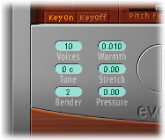Working with Global EVD6 Parameters
The global parameters are found in the lower-left section of the EVD6 interface. They affect the entire EVD6 instrument, rather than an individual model.

- Voices field: Determines the maximum number of voices that can be played simultaneously. Lowering the value of this parameter limits the polyphony and processing requirements of the EVD6. There are two monophonic settings: “mono” and “legato.” Each setting provides a single voice when playing the EVD6.
- Mono: The EVD6 voice is triggered each time a key is pressed.
- Legato: The EVD6 sound-shaping processes are not triggered if the notes are played legato—only the pitch changes. If the notes are played staccato, an EVD6 voice with all sound-shaping processes is triggered.
- Warmth field: Sets the amount of random deviation from an equal-tempered scale. High values add life to sounds. The Warmth parameter can be useful when you are emulating an instrument that has not been tuned for a while, or for slightly thickening a sound. When you are playing chords, the Warmth parameter creates a slight detuning or beating effect between notes.
- Stretch field: The EVD6 is tuned to an equal-tempered scale. You can deviate from this standard tuning by using the Stretch parameter to alter the tuning in the bass and treble ends of the sound. This simulates the way stringed keyboard instruments such as pianos are tuned (see Stretch Tuning in Acoustic Instruments).
Note: Use of both Warmth and Stretch may result in a detuned sound that is quite similar to a heavy chorus effect. In some instances, this effect may be so extreme that the EVD6 sounds out of tune with your project.
- Pressure field: On an original D6, applying pressure (aftertouch) to a depressed key raises the pitch slightly. The Pressure parameter allows you to emulate this behavior. You can also go one better than the original and use the Pressure parameter to lower the pitch slightly with aftertouch messages.